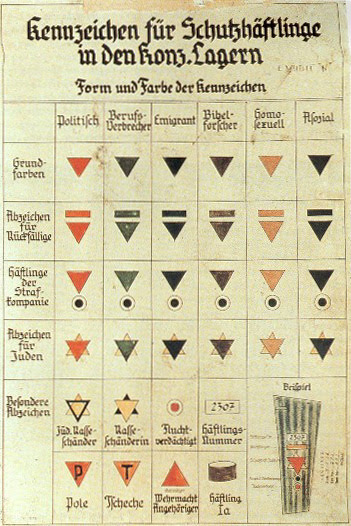For this year’s Holocaust
Memorial Day I thought I’d design a few flags to mark the event. There is
already an established Holocaust Memorial flag, designed in 2005. It is shown
in the illustration at the bottom of this article at the head of 9 other
smaller flags. This flag specifically commemorates the Jews who were victims of
the Holocaust. I thought it would be an idea to commemorate other persecuted
groups individually with their own flag design.
The pink triangle became a
symbol of gay rights in the 1970s (first used in Melbourne, September 1973, as
described here) because it was the symbol used in the Nazi concentration and
labour camps to indicate which prisoners here homosexual. Just as the Jews were
forced to wear yellow triangles on their shirts homosexuals were forced to wear
pink triangles. Each imprisoned group had their own coloured triangle.
The system of triangles
and additional markings used by the Nazis can be confusing, as can be seen in
the chart below, an actual chart of symbols from Nazi Germany. For my flags
I’ve just used the triangles.
When deciding whether a
persecuted group should have a flag I thought about the wider definitions that
were used by the Nazis. In the end I decided that all groups had people who
deserve to be commemorated. For example, you may wonder why I include a flag
with the purple triangle, because that colour represented Jehovah’s Witnesses.
This faith is not known for it’s tolerance of homosexuals, but they were
persecuted none the less for their faith. The purple triangle group also
included people such as Baptists, Adventists and New Apostolics as well as
“Bible students”. And so were people of any faith who preached pacifism.
Pacifists on moral grounds
were grouped with the asocial/anti-social black triangle prisoners. This group
included a large number of people, such as female Roma/Gypsies (male Roma were
given their own triangle later in the war), mental health patients, alcoholics,
drug users, beggars, prostitutes and conscription avoiders. Lesbians have
frequently adopted the black triangle as their symbol because they were
considered anti-social for not wanting to marry and have children.
One group I also debated over
with myself are the green triangle prisoners. These were the convicted
criminals. Those criminals who didn’t receive the death penalty were imprisoned.
However serious or trivial their crime might seem to us imprisonment was their
sentence. They did not deserve to receive inhumane treatment in the
concentration and labour camps any more than the other persecuted groups.
Finally, there is the
Prisoners of War, mainly Soviet soldiers, who were sent to the camps. Their
triangle was pointed up in the opposite direction to the others.
For my designs I
deliberately avoided using the horizontal stripes of the original Holocaust
Memorial flag (there’s far too many horizontally striped flags around, there’s
little variety or distinction). I hope my suggestions for these other memorial
flags will be taken up. At most memorial events the raising of national flags
of allied national and countries who liberated the camps takes place. In my
humble opinion some reminder of the groups who suffered should be commemorated
in the same way.


No comments:
Post a Comment